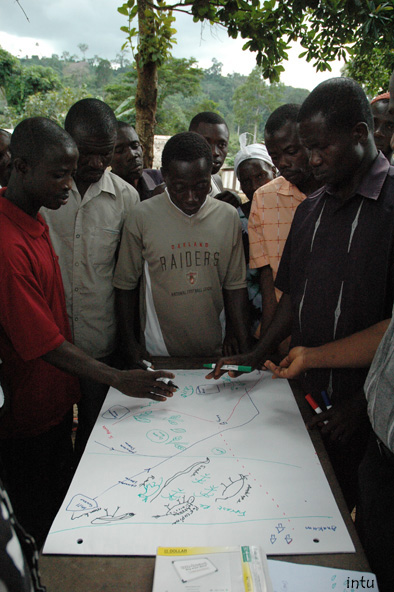The Role of Participatory Modeling in Landscape Approaches to Reconcile Conservation and Development
"In this paper, we examine several case studies where participatory system dynamics modeling was applied to environmental management challenges, and explore how it contributed to promoting a landscape approach. The case studies are drawn from landscapes where conservation and development goals were mutually sought. More specifically, we examine whether participatory modeling helped in conceptualizing the landscape and its dynamics, in exploring possible interventions, and in facilitating discussions among multiple stakeholders. We also present lessons for using participatory modeling..."

Photo: Intu Boedhihartono
"Integrated conservation and development projects emerged in the 1970s and represent major investments by conservation organizations. However, their effectiveness is seriously questioned (McShane and Wells 2003, Garnett et al. 2007). A new wave of investment is now emerging in “landscape approaches” as a way to integrate conservation and development (Sayer and Campbell 2004, Sayer and Maginnis 2005).
Landscapes are considered as mosaics of land cover types that provide environmental services and development opportunities for the multiple needs of diverse stakeholders. A landscape approach seeks to understand landscape dynamics and the desired changes from different viewpoints, the aim being to identify interventions and policies that will achieve the stated goals of stakeholders. Constituting a forum for stakeholder negotiations is a fundamental first step in taking a landscape approach (Sayer and Maginnis 2005).
“Facilitated”, “mediated”, “group”, or “participatory” modeling are terms used for building models with non-modelers under the guidance of a skilled modeler. Participatory modeling has been used in a wide range of situations, including business (Vennix 1996, Vennix et al. 1996), fisheries (Otto and Struben 2004), and environmental decision-making (e.g., Van den Belt et al. 1998, Vanclay et al. 2006). A wide range of model types have been used in participatory modeling, including Bayesian or belief networks (Lynam et al. 2002), agent based modeling (Bousquet and Le Page 2004, Castella et al. 2005) and system dynamics modeling (Van den Belt 2004, Sandker et al. 2007).
Although models are widely used to predict and plan, participatory models serve to explore options and enrich debate. Rouwette et al. (2002) and Lynam et al. (2007)reviewed different cases where participatory modeling was used, and concluded that it improves communication between stakeholders and this increases understanding of complex systems. Akkermans and Vennix (1997) found that five out of six case studies used participatory modeling successfully to create insights and build consensus. This is confirmed by Bousquet et al. (2007) and Castella et al. (2007), who claim that building models with multi-stakeholder groups who have different perceptions and objectives helps build a shared understanding of problems. García-Barrios et al. (2008) report that modeling is particularly effective in stimulating cross-sector strategic thinking, and in helping participants confront the real drivers of change and recognize non-linearities and trade-offs. The modeling process helps participants step back and look beyond their own world view to the holistic landscape picture. All of these characteristics help in the implementation of a landscape approach.
In this paper, we examine several case studies where participatory system dynamics modeling was applied to environmental management challenges, and explore how it contributed to promoting a landscape approach. The case studies are drawn from landscapes where conservation and development goals were mutually sought. More specifically, we examine whether participatory modeling helped in conceptualizing the landscape and its dynamics, in exploring possible interventions, and in facilitating discussions among multiple stakeholders. We also present lessons for using participatory modeling..."



